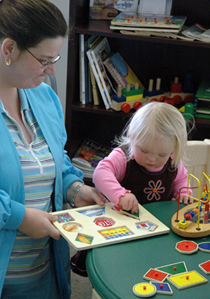Children with Down’s Syndrome
Children with Down’s Syndrome often have difficulties with language. Thus Down’s Syndrome children are usually visual learners and thus need the best vision possible. At birth vision is poor in all children but  gradually improves. In Down’s Syndrome visual acuity may take longer to develop and may be permanently mildly impaired in many patients. Contrast sensitivity is often impaired causing subtle loss of sharpness. Larger and bolder print can be helpful.
gradually improves. In Down’s Syndrome visual acuity may take longer to develop and may be permanently mildly impaired in many patients. Contrast sensitivity is often impaired causing subtle loss of sharpness. Larger and bolder print can be helpful.
Since Down’s Syndrome children also have a higher incidence of nearsightedness, farsightedness and astigmatism, regular eye examination are crucial. They are also less likely to outgrow  these refractive errors as some children do. Reading activities may be effected by reduced focusing ability (accommodation). Some studies have suggested 70% of these children have reduced focusing ability. Some may benefit from bifocal lenses. Those with farsightedness may have an increased risk for crossing of the eyes.
these refractive errors as some children do. Reading activities may be effected by reduced focusing ability (accommodation). Some studies have suggested 70% of these children have reduced focusing ability. Some may benefit from bifocal lenses. Those with farsightedness may have an increased risk for crossing of the eyes.
The fit of eyewear is critical since Down’s Syndrome children have smaller noses and shorter distances from the ears to the eyes which requires a frame with shorter temples. If not properly fit the eyewear will continually slide down the nose. Also when needed bifocal lenses must be fit higher.
Chronic blepharitis, an inflammation of the eyelid margins is common is Down’s patients. Children with Down’s may have allergies to medication such as atropine.
Every child with Down ’s syndrome should be examined within the first six months followed by annual eye exams. Children showing rapid changes in vision should be examined more frequently.
